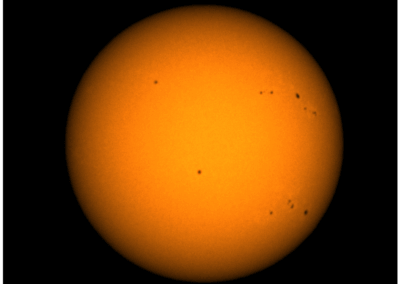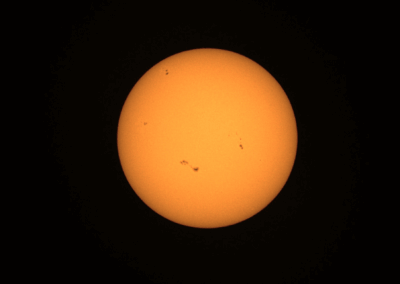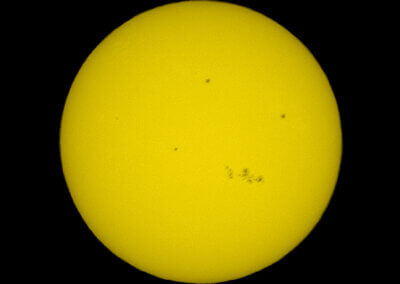OUR STAR, THE SUN
INTRODUCTION : THE SUN’S IMPORTANCE FOR LIFE ON EARTH
The Sun is far more than just a bright object in the sky—it is the gravitational and energetic anchor of our solar system. Located approximately 150 million kilometers (93 million miles) from Earth, it is a massive sphere of hot plasma composed primarily of hydrogen (about 74%) and helium (around 24%). The Sun produces its energy through nuclear fusion in its core, where hydrogen atoms are converted into helium, releasing immense amounts of energy in the process.
WHY IS THE SUN ESSENTIAL FOR LIFE ON EARTH?
Without the Sun, Earth would be a frozen, lifeless rock drifting through space. Its energy drives the climate system, powers photosynthesis (which is the foundation of our food chain), and maintains the temperature ranges needed for liquid water—an essential ingredient for life.
The Sun’s radiation also regulates Earth’s seasons and weather patterns, fuels oceanic and atmospheric circulation, and even influences our sleep-wake cycles through its effect on circadian rhythms. In fact, the entire biosphere is intricately tied to the Sun’s energy output.
Studying the Sun is not only a pursuit of scientific curiosity—it’s essential for understanding the conditions that make Earth habitable, and for predicting space weather phenomena (like solar flares and coronal mass ejections) that can disrupt satellites, GPS, and power grids on Earth.
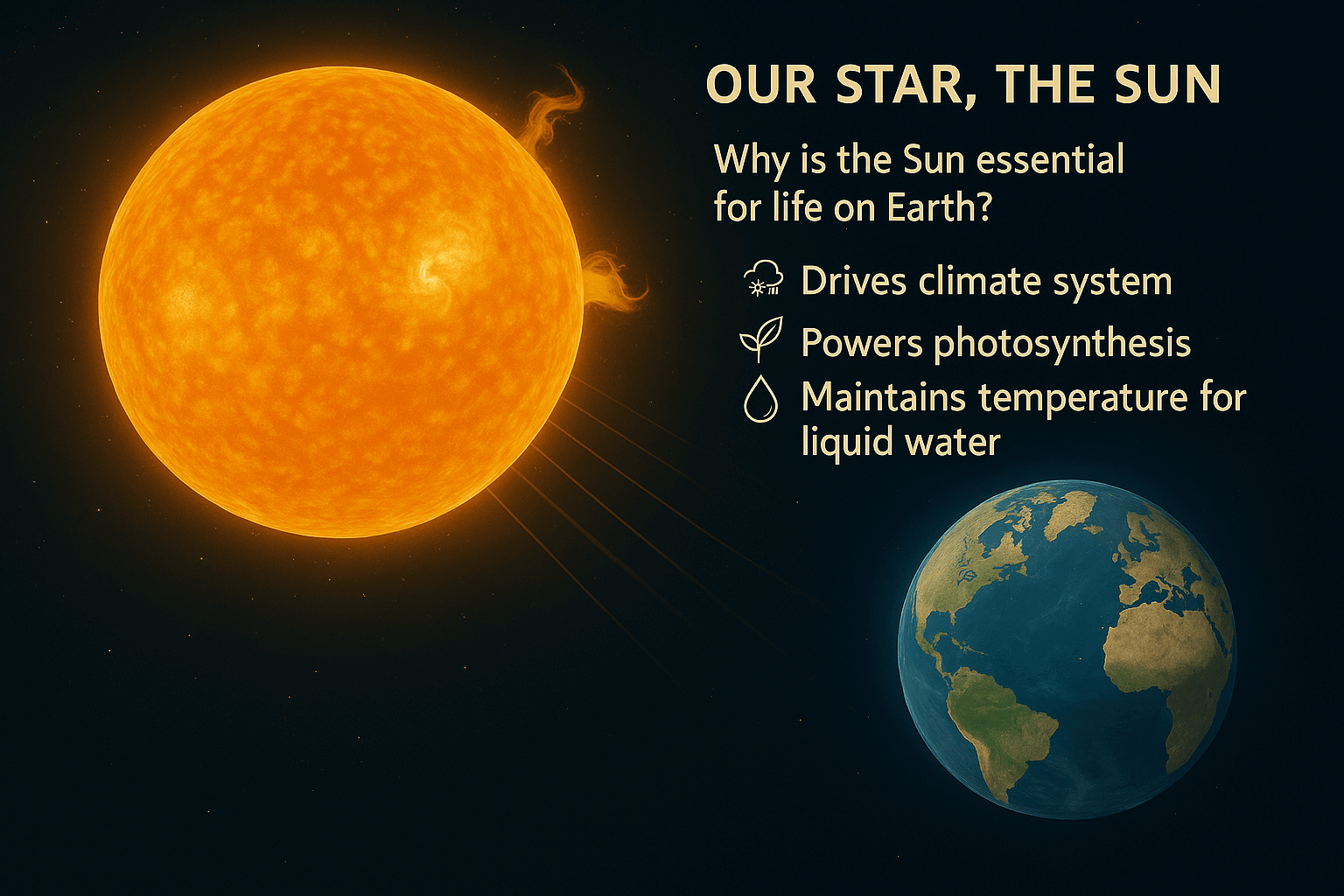
General Features of the Sun
Composition and Characteristics
The Sun is a G2V-type main-sequence star, commonly referred to as a “yellow dwarf.” It contains over 99.8% of the total mass of the solar system, and its gravitational pull governs the motion of all planets, moons, asteroids, and comets.
Composed of roughly 74% hydrogen and 24% helium, with trace elements like oxygen, carbon, and iron, the Sun produces its energy through nuclear fusion in its core. There, hydrogen nuclei fuse into helium under extreme temperature and pressure, releasing energy that radiates outward and powers the entire solar system.
The Sun is structured in several distinct layers:
-
Core – the site of fusion, where temperatures reach ~15 million °C.
-
Radiative Zone – where energy travels slowly outward via photon diffusion.
-
Convective Zone – where hot plasma circulates to bring energy to the surface.
-
Photosphere – the visible surface of the Sun.
-
Chromosphere and Corona – the Sun’s outer atmosphere, visible during solar eclipses and critical to solar activity.

Solar Activity and Phenomena
The Sun is far from stable—it’s a magnetically active star exhibiting powerful and complex phenomena:
-
Sunspots are darker, cooler regions caused by intense magnetic fields that inhibit convection.
-
Solar flares are violent bursts of radiation triggered by magnetic reconnection.
-
Coronal Mass Ejections (CMEs) hurl massive amounts of plasma into space and can trigger geomagnetic storms on Earth.
-
The solar wind, a continuous outflow of charged particles from the corona, shapes the entire heliosphere and affects all planets in the system.
These phenomena follow the 11-year solar cycle, during which solar activity waxes and wanes. At solar maximum, we see more sunspots, flares, and CMEs; during solar minimum, the Sun is quieter. These fluctuations are closely monitored by astronomers and space agencies because of their direct impact on Earth-based and orbital technologies.
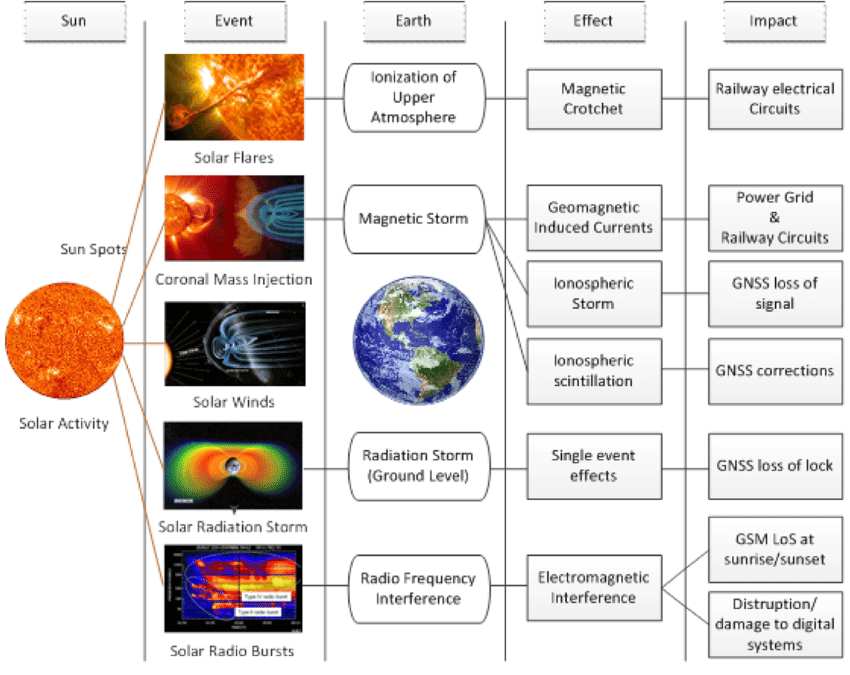
Fun Facts and Fascinating Curiosities
There is some of the Sun’s lesser-known behaviors:
-
Sunlight takes about 8 minutes and 20 seconds to reach Earth, but the energy from the core can take hundreds of thousands of years to reach the surface.
-
The solar corona is hotter than the Sun’s surface—a million °C versus ~5,500 °C—despite being farther from the core. This “coronal heating problem” remains an active field of research.
-
The Sun loses about 4 million tons of mass per second through energy emission, yet remains stable over billions of years. That’s like making 800,000 elephants or 33 Eiffel Towers disappear… every second!
-
It exhibits differential rotation: the equator completes a rotation in ~25 days, while the poles take ~35 days. This contributes to the twisting of magnetic fields and the solar cycle. It’s like a pizza spinning faster at the center than at the edge: it twists everything, especially magnetic fields.
Observing the Sun with Unistellar
THE SMARTEST WAY TO OBSERVE THE SUN
With Goto Sun & Sun Tracking Technology, UNISTELLAR eliminates the hassle of manually pointing your telescope at the Sun, ensuring a smooth, safe, and precise observation.
Smart Solar Filter (SSF): The Key to Safe Solar Observation
Observing the Sun is one of the most awe-inspiring—and dangerous—astronomical experiences. Without proper protection, its intense radiation can permanently damage your eyes or a telescope’s optical system. That’s why Unistellar developed the Smart Solar Filter (SSF): a cutting-edge accessory that allows for safe, high-quality, and effortless solar observation.
Why the SSF Stands Out
Unlike basic solar films or DIY filters, the SSF is engineered to work in harmony with Unistellar’s digital telescopes, combining optical filtration and smart processing for an unmatched observing experience. Here are its key strengths:
-
Absolute safety: Blocks harmful UV and IR radiation and reduces visible light intensity by a factor of 100,000+, fully protecting your eyes and sensors.
-
Plug-and-play simplicity: Just attach the SSF to your telescope; the system automatically calibrates exposure, contrast, and focus.
-
Enhanced solar detail: Observe sunspots, solar granulation, and limb darkening in rich contrast and real-time precision.
• Automatic Sun Detection – No guesswork, no risk. The telescope automatically finds the Sun by detecting subtle brightness gradients in the sky.
• Hands-Free Tracking – Once locked onto the Sun, the telescope tracks it continuously, keeping it perfectly centered throughout your viewing session.
• Optimized for Eclipses – Whether it’s a partial or total eclipse, Unistellar’s smart tech ensures you stay focused on the celestial show.

Solar Eclipses – Nature’s Most Spectacular Celestial Events
Experience the awe of solar eclipses—from partial to total—as the Moon briefly reveals the hidden face of our star. Eclipses offer both emotional wonder and scientific value, especially when observed safely with the Smart Solar Filter. Last year’s total eclipse, captured by our community, was a striking example of this rare alignment.
You can explore it in detail on our dedicated Eclipse Page.
Live the Solar Experience with Unistellar
There’s something deeply moving about observing our star. Whether it’s watching sunspots evolve over days, capturing the majesty of a solar eclipse, or simply seeing the Sun’s surface come alive in real time—Unistellar empowers you to connect with the cosmos safely and intuitively.
With the Smart Solar Filter (SSF) and our connected telescopes, you don’t need to be an expert to experience what was once reserved for professional observatories.
From your backyard, schoolyard, or rooftop, the Sun becomes your star to explore.
Don’t just look at the Sun—observe it.

